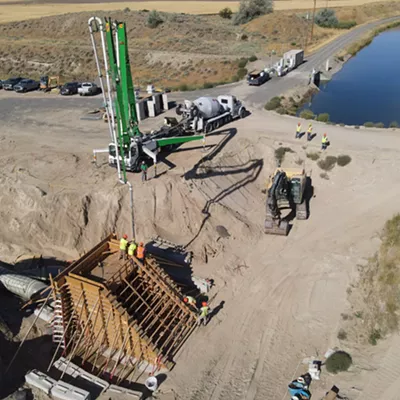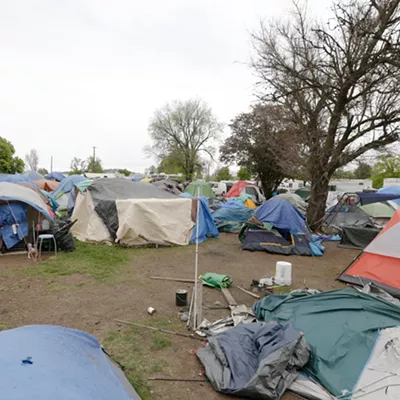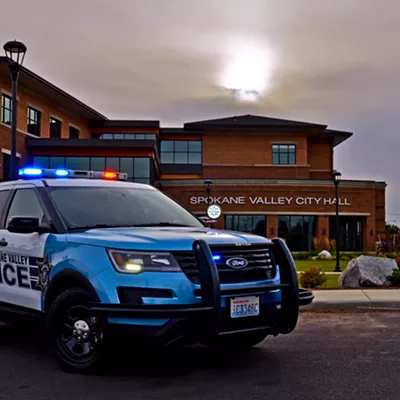At three engagements in Spokane last week, and in some private interviews, LaDuke talked about the need to defend native peoples' rights to the Earth. And this epic debate can fit into a single grain of wild rice -- the Manoominike-Giizis strain, or the "wild rice moon" grown by her people for many generations.
This small grain of plant life serves as a microcosm of the entire sustainability challenge we all face: making sure future generations -- all peoples and all species -- will have a planet worth living on with ecosystems and resources to achieve spiritual and material prosperity.
& lt;span class= "dropcap " & L & lt;/span & aDuke has proven to be so much more than a media darling -- she's a spiritual guide for her tribe and for the thousands she's come across along her journey. Mixing humor with a shaman's intensity, LaDuke has written books like All Our Relations and Recovering the Sacred.
LaDuke sees the Minnesota reservations' practice of harvesting wild rice as vital: "The wild rice harvest of the Anishinaabeg not only feeds the body, it feeds the soul, continuing a tradition which is generations old for these people of the lakes and rivers of the north."
It struck me last week while spending time with LaDuke that her tribe's battle to keep their wild rice wild, free from genetic manipulation, is a much more far-reaching illustration of what sustainability activists consider the struggle of our times: How to create an America that respects the land.
Many of us think along systemic lines, attempting to understand the steps the globe probably has to take to solve the collapsing systems, both environmental and societal. Yet we need reminding that this struggle to work with a burgeoning global human population -- 9 billion by 2050 at the current 1.2 percent growth rate -- needs nudging from storytellers like LaDuke.
Her struggle -- our struggle -- is tied to the biodiversity of wild rice, a sacred food. There are more than 60,000 acres of natural wild rice growing throughout the lakes and rivers of her tribal lands. But there are troubling parallels drawn to what's happened to the sacred corn of Mesoamerica at the hands of the agri-business multinationals, where corn has been patented, controlled and even turned into what some call Frankenfood.
Domestication and genetic modification of wild rice threatens the genetic integrity of this plant. For more than 30 years, plant breeders have developed wild rice for commercial paddies. So today, most of the wild rice on the market comes from these paddies, almost 70 percent of it from California. "Millions of pounds of California wild rice comes into [Minnesota] to be processed," says LaDuke, "some of that rice, if genetically engineered, would irreversibly contaminate our manoomin."
LaDuke's tenacity in understanding the sacred and reclaiming the wholeness of her people's food is a valuable lesson for our times. She's up against the juggernaut of Monsanto and Dupont, the largest seed companies in the world. Monsanto has spent $8 billion in the last few years buying up United States seed companies, while Dupont purchased Pioneer, the second largest seed company in the world.
"This concentration of control over world seed stocks is alarming to farmers on a worldwide scale, especially considering that the closer seeds seem to be held, the fewer there are."
LaDuke puts all of our struggles into a feedback loop, connecting wild rice in Minnesota to sustainability in Spokane with the goal of creating a more independent, safe and stable food supply. "However you cut the statistics," LaDuke says, "from the villages of India to the villages of northern Minnesota, there is a marked loss in worldwide biodiversity, and a closer hold on who controls the remaining seeds of the world."
This issue of control took me back 32 years, to the time I was a newspaper reporter in the middle of a struggle for the soul of a mountain.
Environmentalists were trying to stop my school, the University of Arizona, from building roads and locating a large mirror telescope on Mount Graham, a 10,000-foot sky island sticking out of the Sonora Desert. Mount Graham was named after a white man who rode through the area many years ago, a Colonel James Graham, but for generations the San Carlos Apaches had referred to the entire range as "Pinaleno," meaning "many deer." It's the holiest place for the Apaches, who acquire the power to become medicine men and women through singing and collecting herbs and water on that mountain.
Despite the importance and traditional use of the place, roads were cut and the telescope went up. LaDuke and I talked about that struggle, and she shared many similar struggles currently unfolding in Indian Country and elsewhere.
LaDuke's power is in her ability to unearth the history of Native people's struggles -- and how that history is relevant today. There has been a lost connection between how the land should be used and how it actually is used -- from wild rice in Minnesota to telescopes in Arizona. Reconnecting with the land is another step in the process, as her book puts it, of reclaiming the sacred.
Paul Haeder is the sustainability liaison at Spokane Falls Community College, where he also teaches English. His KYRS radio show, Tipping Points: Voices on the Edge, covers sustainability issues.














